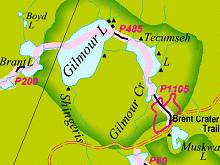Formation of Brent Crater
It was approximately 450 million years ago that a meteor, estimated to have been about 150 meters in diameter, sped to Earth at a point that is now just south of the central north boundary of Algonquin Park.
(Right) Visit the web site of Canada Natural Resources' Continental Geoscience Division for the original high definition photos of the crater..
It was toward the end of Ordovician Period of the Paleozoic Era. Through the mid-Ordovician Period the earth had experienced a mild, moist climate. Marine life had evolved into diverse invertebrates. Beyond the shallow, warm seas only primative plants had started to populate the land.
The meteor's speed was probably close to 20 kilometers per second. It came almost straight down, slicing through surface water and soil deposits like a knife through butter. Within that same second, it punched through into the Precambrian Shield.
Although the meteor likely penetrated no more than twice its own diameter, such was its tremendous kenetic energy, that the resulting shockwaves vapourized and melted both the meteor and a large volume of the bedrock. The expanding shockwaves started out at several kilometers per second shattering even more rock, ejecting it outward and upward.
Below the ejection zone, the continuing shockwaves produce a displacement zone where material was driven first downward and then outward, resulting in the uplifting of the crater's rim.
On-site core drilling has revealed that pressures 850 meters below the impact had been so great that a "lens of shock-melted rock" or "melt zone" was created .
It is estimated that the "excavation" of the crater was completed in less than ten seconds and that the explosion equalled that of 250 million tons of TNT.

Photos are reproduced with the permission of the Minister of Public Works and Government Services Canada, 2002 and Courtesy of Natural Resources Canada, Geological Survey of Canada.


